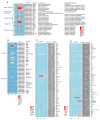Transcriptomic Identification of Key Genes Responding to High Heat Stress in Moso Bamboo (Phyllostachys edulis)
- PMID: 40869903
- PMCID: PMC12386143
- DOI: 10.3390/genes16080855
Transcriptomic Identification of Key Genes Responding to High Heat Stress in Moso Bamboo (Phyllostachys edulis)
Abstract
Background/Objectives: Moso bamboo (Phyllostachys edulis), the most widely distributed bamboo species in China, is valued for both its shoots and timber. This species often faces challenges from high-temperature stress. To cope with this stress, Moso bamboo has evolved various adaptive mechanisms at the physiological and molecular levels. Although numerous studies have revealed that a large number of transcription factors (TFs) and genes play important roles in the regulatory network of plant heat stress responses, the regulatory network involved in heat responses remains incompletely understood. Methods: In this study, Moso bamboo was placed in a high-temperature environment of 42 °C for 1 h and 24 h, and transcriptome sequencing was carried out to accurately identify key molecules affected by high temperature and their related biological pathways. Results: Through a differential expression analysis, we successfully identified a series of key candidate genes and transcription factors involved in heat stress responses, including members of the ethylene response factor, HSF, WRKY, MYB, and bHLH families. Notably, in addition to traditional heat shock proteins/factors, multiple genes related to lipid metabolism, antioxidant enzymes, dehydration responses, and hormone signal transduction were found to play significant roles in heat stress responses. To further verify the changes in the expression of these genes, we used qRT-PCR technology for detection, and the results strongly supported their key roles in cellular physiological processes and heat stress responses. Conclusions: This study not only deepens our understanding of plant strategies for coping with and defending against extreme abiotic stresses but also provides valuable insights for future research on heat tolerance in Moso bamboo and other plants.
Keywords: Moso bamboo (Phyllostachys edulis); heat stress responses; key genes; regulatory network.
Conflict of interest statement
The authors declare no conflict of interest.
Figures









References
-
- Xiong Y., Liu X.-Q., Xiao P.-A., Tang G.-H., Liu S.-H., Lou B.-H., Wang J.-J., Jiang H.-B. Comparative transcriptome analysis reveals differentially expressed genes in the Asian citrus psyllid (Diaphorina citri) upon heat shock. Comp. Biochem. Physiol. D Genom. Proteom. 2019;30:256–261. doi: 10.1016/j.cbd.2019.03.009. - DOI - PubMed
-
- Wu H., Su X., Huang S., Singh V.P., Zhou S., Tan X., Hu X. Decreasing dynamic predictability of global agricultural drought with warming climate. Nat. Clim. Change. 2025;15:411–419. doi: 10.1038/s41558-025-02289-y. - DOI
-
- Ahmad L., Biswas A., Warland J., Anjum I. Climate Change and Agrometeorology. Springer Nature; Cham, Switzerland: 2023.
MeSH terms
Substances
Grants and funding
LinkOut - more resources
Full Text Sources

